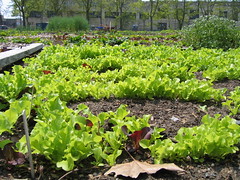 Image by ambienttraffic via FlickrUrban Agriculture
Image by ambienttraffic via FlickrUrban Agriculture
Guest Post by Stesha Parrish
Urban agriculture defined in simple terms is the growing, processing, and distribution of food and other products through intensive plant cultivation and animal husbandry in and around cities. (North American Urban Agriculture Committee.) It includes green belts around cities, farming at the urban fringe, vegetable plots in community gardens, and food production in thousands of vacant inner-city lots. Urban agriculture comprises fish farms, farm animals at public housing sites, municipal compost facilities, schoolyard greenhouses and gardens, restaurant-supported salad gardens, backyard orchards, rooftop gardens and beehives, window box gardens, and so much more.
There is a growing consumer demand for fresh, local, and often organic food which in turn creates new markets for urban food production. Many of these efforts specifically address the needs of urban residents who are living in poverty, and consequently experience poor nutrition, hunger, and anxiety about not having enough to eat. The potential for food production in cities is great, and dozens of model projects are demonstrating successfully that urban agriculture is both necessary and viable.
Approximately 80 percent of the United States population lives in urban areas and this is projected to continue to grow. This is an amazing contrast when compared to 100-years ago when 50 percent of Americans lived on subsistence farms or in small rural towns where communities fed themselves with locally grown foods. More food is now shipped from markets outside the United States to feed our citizens than at any other time in history. (Community Food Security Coalition) Food typically travels between 1,500 and 2,500 miles from farm to table, with as much as 25 percent traveling farther than food did in 1980. This distance traveled accounts for nearly 50% of food which is lost to spoilage. (Community Food Security Coalition) This in turn makes most fruit and vegetable varieties chosen to be sold in supermarkets based on their ability to withstand industrial harvesting and extended travel and not for their nutritional quality or taste.
It has been suggested that every community should be able to produce at least a third of the food required by its citizens at any given time in order to prepare for emergencies. At present, less than five percent is being produced. (Mann) If there was a natural disaster resulting in a loss of production within a particular area that held large-scale producers, then our nations food supply would be severely disrupted, resulting in many going hungry. Our food supply became very vulnerable and unpredictable when it left our family farms.
Paradox In The Land Of Plenty
One of the worst paradoxes in agricultural history is due to the current food system structure which results in hunger amongst the plenty of food produced. Thirty-three million people live in households that experience hunger or the risk of hunger. Food insecurity in the United States is represented by people who frequently skip meals or eat too little, sometimes going without food for the entire day. There is an increasing number of Americans who are experiencing food insecurity. (Community Food Security Coalition) As the economy continues to decline and uncertainty grows, so will our food security.
With most of our food traveling such great distances and being produced off of a petroleum based production system, food costs will continue to rise making nutritious, affordable food less available to those already in need. Already many inner-city grocery stores charge higher prices for basic food items and the quality of food is lacking in small neighborhood stores. (Fisher, 1999) This seems to be unproductive in assisting those who need help with those more likely to be on tighter fixed incomes being forced to pay more for their food than their wealthier counterparts.
Food insecurity, in whatever form it may come, affects the quality of life for urban residents in many different ways. Inadequate nutrition and food insecurity can have many adverse effects on an individual and community including more health care costs, sickness, disease, fatigue, higher emotional stress, and increased crime rates within the area affected. Urban agriculture offers aid to those experiencing this. More food security results in more physical and mental health of a community and also less crime and city services that are required within that community.
Urban agriculture can help revitalize a community with beauty and give its citizens a sense of pride and togetherness that it may have been previously lacking. Vacant and abandoned lots litter inner city neighborhoods with run down buildings and overgrown forgotten places that often attract crime. These neighborhood eye-sores can easily become a positive gathering place that brings community members together and benefits all involved. Many cities are transforming these types of lots into community green spaces and community food gardens that create a sense of unity and provide nutrition for those who surround it.
Cities are finding uses for other unused areas as well. Some schools are and hospitals are starting orchards and food gardens where once only turf grass or ornamental plantings where found. The food produced from these are being used to feed the students, patients, being used as a source of education, therapy, and given back to the community. Portions of city parks are being turned into edible and visual delight landscaping. Food is being produced in utility right of ways and many roof tops have been converted into productive spaces for growing food. There are many organizations being formed to promote and encourage cities to make this transition such as New York City’s “Earth Pledge.”
Urban agriculture offers residents local, healthful, accessible, and affordable food in a sustainable and realistic manner. It also offers entrepreneurial opportunities to those who previously thought they had no other option. There is a growing demand for local healthy food across the nation and many are finding a niche within that market. Many times the elderly and refugees have a wealth of knowledge about growing and preserving food that can be utilized in creating income and nutrition for their families.
Making The Difference
Many community and inner-city gardeners combine their produce to sell to restaurants or at farmers markets. Community supported agriculture (CSA) is on the rise and help keep these urban farmers afloat between growing seasons. Food From the ‘Hood (FFTH) was the nation’s first student managed natural food products company that is based out of inner Los Angeles. It has managed to award over $140,000 in scholarships to students and supported itself since 1992. (FFTH) Intensive gardening methods are used in cities to produce yields up to thirteen times greater per acre than their rural counterpart. This utilization of space creates great potential for profit and food security within a particular area and is available to anyone who chooses to attempt it.
Many cities have successfully transitioned into a secure food supply system by using urban agricultural practices. The oil embargo of 1973 forced Cuba start producing its own food and utilize all resources available to feed the nations population. Cuba successfully managed to prevent the starvation of a multitude of inner city inhabitants by people banding together and growing food in even the smallest of areas available. Havana currently still produces one-half of the vegetables consumed by its citizens within the cities farms and gardens. (Cuba Survived)
Singapore has 10,000 urban farmers who produce eighty percent of poultry and twenty-five percent of the vegetables consumed. (Smit, 1996) Fourteen percent of London’s residents grow food gardens providing eighteen percent of their nutritional needs (Garnett, 1999) and forty-four percent of Vancouver’s residents do the same (City Farmer). U.S. counties adjacent to or within metropolitan areas grow seventy-nine percent of the fruit, sixty-eight percent of the vegetables, and fifty-two percent of the dairy products produced in the United States. (Heimlich, 1993) However, few dollars generated by these farms actually remain in the area that produces them. Small urban farmers have the potential to not only provide food security to their communities, but also economic stability with locally owned and operated business keeping money moving within a community.
Urban agriculture offers a variety of ways to help feed a community through schoolyard greenhouses and gardens, restaurant-supported salad gardens, backyard orchards, rooftop gardens and beehives, window box gardens, and many more techniques. These are affordable, realistic, and offers healthy, nutritious, affordable, and accessible food to a community that previously may not of had this option.
Urban Agriculture can stimulate a local economy by offering local organic produce that is already in demand, creating jobs where there once were none and keeping money circulating within the community. Urban agriculture offers a solution to they run down vacant lots scattered throughout cities across America, and turns them into a peaceful social gathering place that unites communities and neighborhoods alike. It can provide food security to families and communities across the nation that once did not have access or could not afford nutritious food for their families. Communities are capable of producing at least half of their dietary needs through roof top gardens, and other alternative areas with intensive growing techniques that offer high yield crops.
It is possible with documented cases such as the major cities of Havana, Cuba, Moscow, Russia, London, England, Vancouver, Canada, and Singapore’s residents all producing a good portion of their food within the city limits themselves. If we learn from these examples and put into practice basic backyard or window box gardening we could eventually end up becoming less dependant on tasteless food that has traveled thousands of miles with inadequate nutrition that took money out of the area it was grown.
This entire concept is un-American and we, as a Nation, need to wake up and remember how important our food is. Teaching our neighbors and our children how to grow their food and increasing the knowledge of where it all comes from will increase the overall health of our nation’s residents and peace of mind.
References
Fisher, A. 1999. Hot Peppers and Parking Lot Peaches : Evaluating Farmer’s Markets in Low-Income Communities. Retrieved November 25, 2008 from http://www.foodsecurity.org/HotPeppersPeaches.pdf
Mann, P. Why Homeland Security Must Include Food Security. World Hunger Year (WHY) Speaks. Retrieved on November 27, 2008 from http://www.worldhungeryear.org/why_speaks/ws_load.asp?file=20&style=ws_table
Food From the ‘Hood (FFTH) homepage www.foodfromthehood.com
Quinn, M. 2006. The Power of Community : Howe Cuba Survived Peak Oil. Permaculture Activist. Retrieved on November 30, 2008 from http://globalpublicmedia.com/articles/657
Smit, J. A. Ratta, and J. Nasr. 1996. Ruban Agriculture : Food, Jobs, and Sustainable Cities. Untied Nations Development Programme. Retrieved on November 30, 2008 from http://www.energyandenvironment.undp.org/undp/indexAction.cfm?module=Library&action=GetFile&DocumentAttachmentID=2388
Garnett, T. 1996. Growing Food in Cities : A report to highlight and promote the benefits of urban agriculture in the UK. Retrieved on November 24, 2008 from http://www.peoplesgrocery.org/brahm/wp-content/uploads/2006/10/growing%20food%20in%20cities.pdf
City Farmer Homepage. 2002. 44% of Vancouver Households Grow Food. Retrieved on November 28, 2008 from http://www.cityfarmer.org/44percent.html
Heimlich, R. and C. Bernanard. 1993. Agricultural Adaptation to Urbanization : Farm Types in the United States Metropolitan Area. Retrieved on November 29, 2008 from http://ageconsearch.umn.edu/bitstream/28849/1/21010050.pdf
Community Food Security Homepage www.foodsecurity.org
North American Urban Agriculture Committee. 2003. Urban Agriculture and Community Food Security in the United States : Farming from the City Center to the Urban Fringe. A Primer Prepared by the Ciommunity Food Security Coalition’s North American Urban Agriculture Committee. Retrieved on November 30, 2008 from http://www.foodsecurity.org/PrimerCFSCUAC.pdf
Bailkey, M. and J. Nasr. From Brownfields to Greenfields : Producing Food in North American Cities. Community Food Security News. Fall 1999/Winter 2006:6
~~Stesha~~


